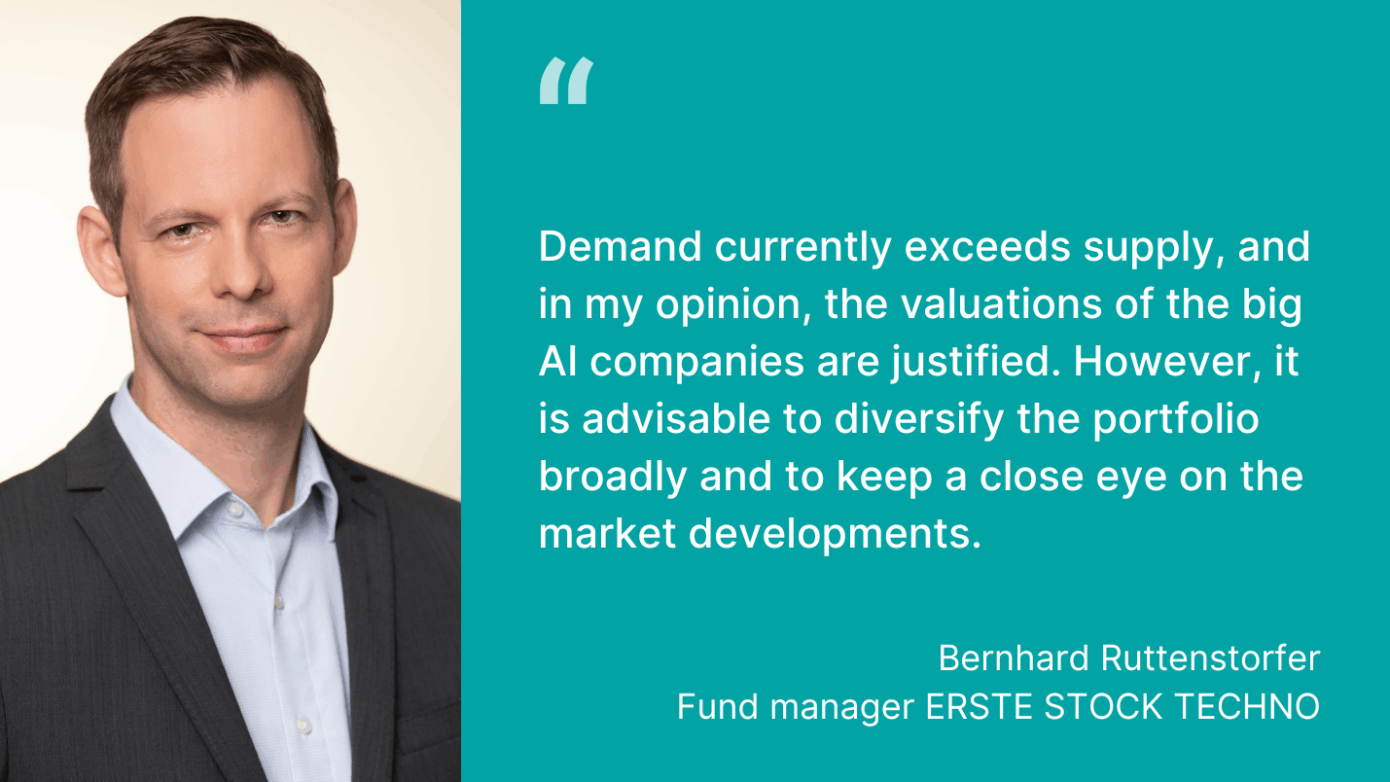Investors worldwide are concerning themselves with the question of whether current developments in artificial intelligence (AI) are creating a bubble on the equity markets, or whether they are actually heralding a new era of value creation. Billions are flowing into infrastructure, chips, and data centres – but what is really behind the boom? Bernhard Ruttenstorfer, fund manager of ERSTE STOCK TECHNO, assesses the situation.
Some tech companies currently command high valuations on the equity markets, and many players are talking about an “AI bubble”. How do you assess the current market dynamics, not at least taking into account the example of Nvidia’s recently presented results?
I think the discussion about an AI bubble is too simplistic. What we are currently experiencing is not a short-term hype, but the establishment of a new industrial base. The investments in data centres, chips, and electricity infrastructure are enormous and geared towards the long term. Global computing capacity is expected to multiply by 2035 – companies that are not among the traditional hyperscalers such as Amazon or Google will create capacities in the next ten years that are twice as large as those of all hyperscalers in 2024. These account for about 50% of the computing demand generated by AI. Companies outside the area of hyperscalers will invest around USD 2 trillion in expansion. The order books of the major providers are already thoroughly filled for the next few years. This illustrates that the situation is not based on hope, but on real demand and sustainable growth.
Please note: The companies listed here have been selected as examples and do not constitute investment recommendations. Investing in securities involves risks as well as opportunities.
Encyclopaedia: what are hyperscalers?
Hyperscalers are companies that operate extremely large, globally distributed IT infrastructures and thus offer cloud services, storage, and computing power on an industrial scale. Among the best-known hyperscalers are Amazon Web Services (AWS), Microsoft Azure, and Google Cloud. They are characterised by their ability to provide IT resources flexibly and to an almost unlimited degree and are key players in the field of digitalisation and artificial intelligence. Hyperscalers continuously invest in new data centres and innovative technologies to meet the growing demand for cloud and AI applications.
What distinguishes current AI investments from previous technology cycles?
The key difference is the infrastructure. Companies are investing heavily in hardware and networks to create the conditions for AI applications. Whoever provides the infrastructure has the most leverage in the value chain. The demand for computing power and chips is so significant that it exceeds supply, as can be seen in the high utilisation rates of data centres.
What role do large technology groups play in the AI boom?
The driving force behind this is clearly the established technology companies. They have the necessary resources, cash flows, and distribution networks to not only develop AI, but also to monetise it. Whereas many start-ups are still searching for viable business models, the tech giants are already successfully using AI in cloud services, advertising, and enterprise software. It is particularly noteworthy that, for the first time in years, we can see measurable productivity gains in large companies – clear evidence of the economic benefits of AI.

What risks can you see despite the investment boom?
Of course, there are risks. Individual shares can overheat in the short term, and there is a certain amount of investment pressure. Power shortages and geopolitical tensions in supply chains should not be underestimated either. Still, these risks are primarily of a cyclical nature and do not pose a structural threat to the system. The basis for the boom is real: electricity, silicon, fibre optics, and capital.
If we experience a technical correction after a sharp rise in prices over many weeks and months and some investors take profits, this does not come as a surprise. A real bubble only arises when there is no economic basis – this is not the case here. The investment wave will adjust and correct itself, but it will not disappear.
What should investors bear in mind when investing in the AI sector?
Investors should distinguish between short-term trends and sustainable business models. It is worth investing in companies that not only benefit from the AI hype but also create real value – especially in the areas of infrastructure and hardware. Demand currently exceeds supply, and in my opinion, the valuations of the big AI companies are justified. However, it is advisable to diversify the portfolio broadly and to keep a close eye on the market developments in order to minimise risks and make the most of opportunities.
Investing in future-related topics such as AI and cybersecurity
The ERSTE STOCK TECHNO equity fund focuses on leading companies in the technology sector. In addition to artificial intelligence, cybersecurity is also one of its key areas of focus.
👉 Find out more
Risk notes ERSTE STOCK TECHNO
The fund employs an active investment policy and is not oriented towards a benchmark. The assets are selected on a discretionary basis and the scope of discretion of the management company is not limited.
For further information on the sustainable focus of ERSTE STOCK TECHNO as well as on the disclosures in accordance with the Disclosure Regulation (Regulation (EU) 2019/2088) and the Taxonomy Regulation (Regulation (EU) 2020/852), please refer to the current Prospectus, section 12 and the Annex “Sustainability Principles”. In deciding to invest in ERSTE STOCK TECHNO, consideration should be given to any characteristics or objectives of the ERSTE STOCK TECHNO as described in the Fund Documents.
Legal disclaimer
This document is an advertisement. Unless indicated otherwise, source: Erste Asset Management GmbH. The language of communication of the sales offices is German and the languages of communication of the Management Company also include English.
The prospectus for UCITS funds (including any amendments) is prepared and published in accordance with the provisions of the InvFG 2011 as amended. Information for Investors pursuant to § 21 AIFMG is prepared for the alternative investment funds (AIF) administered by Erste Asset Management GmbH pursuant to the provisions of the AIFMG in conjunction with the InvFG 2011.
The currently valid versions of the prospectus, the Information for Investors pursuant to § 21 AIFMG, and the key information document can be found on the website www.erste-am.com under “Mandatory publications” and can be obtained free of charge by interested investors at the offices of the Management Company and at the offices of the depositary bank. The exact date of the most recent publication of the prospectus, the languages in which the fund prospectus or the Information for Investors pursuant to Art 21 AIFMG and the key information document are available, and any other locations where the documents can be obtained are indicated on the website www.erste-am.com. A summary of the investor rights is available in German and English on the website www.erste-am.com/investor-rights and can also be obtained from the Management Company.
The Management Company can decide to suspend the provisions it has taken for the sale of unit certificates in other countries in accordance with the regulatory requirements.
Note: You are about to purchase a product that may be difficult to understand. We recommend that you read the indicated fund documents before making an investment decision. In addition to the locations listed above, you can obtain these documents free of charge at the offices of the referring Sparkassen bank and the offices of Erste Bank der oesterreichischen Sparkassen AG. You can also access these documents electronically at www.erste-am.com.
Our analyses and conclusions are general in nature and do not take into account the individual characteristics of our investors in terms of earnings, taxation, experience and knowledge, investment objective, financial position, capacity for loss, and risk tolerance. Past performance is not a reliable indicator of the future performance of a fund.
Please note: Investments in securities entail risks in addition to the opportunities presented here. The value of units and their earnings can rise and fall. Changes in exchange rates can also have a positive or negative effect on the value of an investment. For this reason, you may receive less than your originally invested amount when you redeem your units. Persons who are interested in purchasing units in investment funds are advised to read the current fund prospectus(es) and the Information for Investors pursuant to § 21 AIFMG, especially the risk notices they contain, before making an investment decision. If the fund currency is different than the investor’s home currency, changes in the relevant exchange rate can positively or negatively influence the value of the investment and the amount of the costs associated with the fund in the home currency.
We are not permitted to directly or indirectly offer, sell, transfer, or deliver this financial product to natural or legal persons whose place of residence or domicile is located in a country where this is legally prohibited. In this case, we may not provide any product information, either.
Please consult the corresponding information in the fund prospectus and the Information for Investors pursuant to § 21 AIFMG for restrictions on the sale of the fund to American or Russian citizens.
It is expressly noted that this communication does not provide any investment recommendations, but only expresses our current market assessment. Thus, this communication is not a substitute for investment advice.
This document does not represent a sales activity of the Management Company and therefore may not be construed as an offer for the purchase or sale of financial or investment instruments.
Erste Asset Management GmbH is affiliated with the Erste Bank and austrian Sparkassen banks.
Please also read the “Information about us and our securities services” published by your bank.


